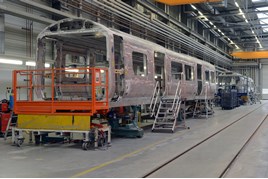“It really is quite impressive - 24 trains an hour north to south, and 24 trains an hour east to west. It’s going to make a big difference. It obviously affects the Underground - the Underground is going to be overloaded in certain places, and it’s helping move passengers away from St Pancras and out into London quickly. And it’s reducing the interchange needs between the main line terminals, so people can do more journeys across London without having to keep changing trains all the time.”
Smith discusses the depots that will house the ‘700s’: “Hornsey is a depot which is very difficult to stage. Like open heart surgery, we have to keep the patient alive while we’re ripping them to pieces and putting them back together again. So we had a series of stages at Hornsey that was very critical to get right.
“We had two or three of those last year. Our big project at Christmas this year was a major remodelling in the south end of Hornsey depot. It was one of those lifetime opportunities - a 90-hour possession available last Christmas, and we had the railway part, the south end of Hornsey depot. And before you ask, we had nothing to with East Coast at Christmas!”
The Hornsey work is due to be completed in July 2016. Meanwhile, in July this year, Three Bridges depot will be completed, “ready to receive the first train, which arrives at the beginning of August, and start its UK-side programme”.
Smith adds: “In December 2015, we expect to give GTR its first train, to hand it over ready for operational use. February 2016 is when GTR first intends to run a significant passenger service with that train.”
Regarding the ‘700s’, he says: “Designs have been completed ahead of time, manufacturing is ahead of or as per programme, and all key dates have basically been met so far on the programme. Currently we have six full-length units, so that’s six four-car units in testing. The seventh is due this month, and we have one reduced-length unit, an eight-car that is also at Wildenrath for the test unit involved in car-specific issues.”
Behind Smith are where the trains are being built, and the line on which trains are hauled from the factory for testing and delivery to their various destinations. It is not just the UK for which the factory builds trains - trains for Germany and Turkey are also currently under construction.
Says Smith: “We’re now at the stage where we have another 200 body shells being manufactured - 20% of the body shells have already been produced in the factory here. Wildenrath’s all ready for the next stage.
“There is a big ramp-up of production to get to where we need, the two vehicles per day that starts in September. That is where we really start to wind up the process.”
He talks specifically of 700101: “This train went through climatic testing in the early part of last year - in the Vienna fridge/oven, depending which way it’s turned at the time. It was quite an extensive series of tests. We threw snow at it; we froze it; we put ice in the doors. Every element and every system was tested. In fact, the air-conditioning was tested with extreme temperatures. We tested the airflows around the various areas where the grilles are going to get blocked up.
“Some changes were done as a result, in terms of improving its performance in extreme conditions. So while you could go never go entirely against every scenario, we’ve done everything that we reasonably can.”
Smith also discusses how the trains will be able to operate through the Central London Core. To reach 24tph, Automatic Train Operation (ATO) will be used. Further out, a Driver Advisory System (DAS) will be used to allow Network Rail to guide drivers.
“The Central Core will be controlled by ATO, which we’ve already tested here. Within 20 minutes of the Core, the Core sector flight control is very much embedded into this, so that trains present at the right point at the right junctions at the right time, so we get the smoothest possible flow of those 24 trains an hour. That is built on a Driver Advisory System - Network Rail will basically be telling the driver, through the driver system, what they will be driving through.
“Outside that, trains are being supervised by Network Rail’s train management system, to identify what the driver needs to be doing across the Core. So it’s not a novel way of doing this, but it’s an essential way to get those 24 trains an hour from the centre, to be able to guide them to the right paths, rather than have them start when you get to the junctions.
“That does need a simulator to get all this to work, in theory. We have provided the train-based kit, which basically mimics the train and signals rail information across the kit. And a lot of work is being done to mimic this pattern to try and restart that, before we get to the test station in Hertford North.”
Sabri Esslimani, Siemens AG head of assembly at Krefeld Manufacturing Facility, tells RAIL about the factory. “It is 253,190m2 and has approximately 2,500 staff. Approximately 600 cars per year leave the factory.” He says 150 apprentices are based there, and that quality control is key - Esslimani is constantly on the lookout for improvements.
He explains that construction of the SWT Class 707s begins in June. The work starts with the small parts and front ends, and then the large components are added, such as the car body. There is also sand blasting and painting. Each stage of the process (there are five in total) has a Quality Gate.
In the pre-assembly area, the windows, toilets, HVAC and couplers, as well as wiring, are among the components added. By this point the ‘700’ vehicle has already had its metal pressed, and the vehicle is then welded together in ‘The Cathedral’, which adds the roof to the bodyside and floor. Bogie fitting is carried out at the third stage, and then comes the electrical testing. Because of the scale of the Thameslink project, Esslimani says that has been integrated with the assembly stage.
















Login to comment
Comments
No comments have been made yet.